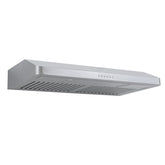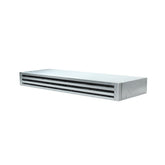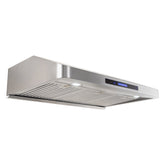Ensuring your outdoor range hood stands the test of time doesn’t have to be a challenge. This article cuts through the complexity to offer straightforward tips on extending the life of your outdoor range hood. Prepare to transform routine care into lasting performance, without feeling overwhelmed by the details.
Key Takeaways
- Selecting the right outdoor range hood requires considering materials—for durability 304 stainless steel—appropriate size for cooktop coverage, and a style that enhances ventilation and complements the kitchen’s layout.
- Maintaining an outdoor range hood is essential for longevity, involving regular cleaning of the hood, filters, and fan blades, as well as biannual inspections and proactive measures to avoid wear and tear.
- Protecting the outdoor range hood from environmental factors like harsh weather conditions is key; using weatherproof covers and ensuring proper installation height and secure anchoring can preserve its integrity and functionality.
Choosing the Right Outdoor Range Hood

Choosing an outdoor range hood capable of withstanding harsh elements is like picking out armor for your kitchen – it’s a critical shield against exhaust, smoke, and impurities.
While indoor range hoods may be a fine match for a controlled environment, outdoor range hoods require a different caliber of resilience. With the right materials and design, a high-quality range hood not only protects against moisture damage but could also last 20+ years.
And let’s not forget, a well-chosen hood adds a touch of elegance to your outdoor kitchen’s aesthetic while taking on the heavy lifting of venting out heat and grease.
A key factor to consider is the range hood’s exterior, as it plays a crucial role in its durability and performance.
Material Considerations
When it comes to materials, not all heroes wear capes, but the best outdoor range hoods do come clad in 304 stainless steel. The sheen of 304 stainless steel isn’t purely aesthetic; it provides a strong defense against the ravages of weather and high temperatures, perfect for the outdoor kitchen battlefield. Its corrosion-resistant properties are akin to a knight’s shining armor, ensuring that your range hood doesn’t succumb to the ravages of time.
Don’t forget, maintaining the internal components is crucial for the long life of your outdoor kitchen companion.

Size and Style
Size is indeed important when selecting the perfect range hood for your outdoor kitchen. For optimal coverage, a hood should gracefully extend its six inches beyond the cooktop on each side. Whether it’s a robust wall-mounted range hood or elegant island range hoods, the chosen style should not only complement your kitchen’s layout but also enhance ventilation efficiency.
It’s a balancing act of form and function, where the right range hood becomes an integral part of your outdoor kitchen’s symphony.
Regular Cleaning and Maintenance

Regular cleaning and range hood maintenance is one of the secrets to the long-lasting beauty and performance of outdoor range hoods. Just as a knight keeps his sword polished and ready for battle, your range hood requires monthly attention with a warm soapy water to fend off the foes of grease and dirt. This not only ensures that your range hood maintains its lustrous sheen but also keeps it operating at peak efficiency for years to come.
Also, conducting a biannual inspection is not merely a good habit – it’s a proactive measure against wear and tear. We do ours in the spring and fall as we winterize our outdoor kitchen and then as we ready it for Spring.
Filter Maintenance
Your range hood’s effectiveness largely depends on its range hood filter, these overlooked guardians trap grease and prevent degradation of your hood's performance.
Regularly cleaning or replacing hood filters is a ritual that must be observed every one to three months, depending on how you use your hood.
This diligence extends the time between blower cleanings and ensures that your kitchen air remains fresh and clean.
Opt for high-quality, dishwasher-safe stainless steel baffle filters to weather the storm of outdoor conditions with grace and minimal maintenance.
Exterior Surface Cleaning
The exterior of a stainless steel range hood is not simply a surface; it mirrors the essence of your kitchen. To maintain its allure, you can follow these steps:
- Concoct a gentle potion of dish soap and warm water, or use a stainless steel cleaner or a stainless steel polish.
- Wipe away the grime and residue from the elements, following the grain of the steel.
- For stubborn stains, arm yourself with acetone or a degreaser to restore peace to your hood’s surface.
Once the surface is clean with a cleaning solution, a touch of olive oil or coconut oil can serve as a polishing elixir, ensuring that your range hood gleams in the morning sun.
Fan Blade Care
Fan blades, the relentless workhorses of your range hood, need occasional pampering. Here’s how to clean and maintain them:
Protecting Your Outdoor Range Hood
Outdoor cooking is laden with environmental challenges, from harsh rain to intense sunlight. But fear not, for there are armaments designed to protect your outdoor range hood from such assailants. By using weather-resistant or weather-proof materials in your outdoor kitchen you create a bulwark against frost and moisture, safeguarding your range hood’s integrity and longevity.
Weatherproof Covering
When your range hood is off-duty from overseeing your grill, a high-quality weatherproof cover acts as its protector, warding off dirt, debris, and the relentless advance of moisture. Such covers are the silent guardians, ensuring every inch of your range hood is enveloped in a protective embrace, thus preventing the creeping curse of rust and damage.
Proper Installation
Correct installation forms the basis for your range hood’s efficiency and safety. Sturdily perched 36 to 42 inches above the cooktop, it can perform its duties without succumbing to the heat of battle. Securely anchored to the steadfast beams of your kitchen’s structure, it stands ready to face the gusts and gustations of outdoor cooking.
Beware the pitfalls of improper duct termination and venting into enclosed spaces, for they are treacherous foes that can turn your kitchen’s air into a maelstrom of mold and smoke.
Troubleshooting Common Outdoor Range Hood Issues

Even the most resilient range hoods might stumble, hindered by common issues that obstruct their primary function. Vigilance is your ally, for addressing these issues promptly safeguards the lifespan and performance of your culinary protector.
Inspect the vents for signs of blockage and heed the whisper of decreased suction, for these omens portend troubles that can be vanquished with a cleaner’s touch or a filter’s renewal.
Decreased Suction Power
Decreased suction power is an affliction that can be remedied with a keen eye and a diligent hand. Grease, the silent adversary, may have laid siege to your hood’s vent, but its efforts are futile against your resolve to clean or replace the ensnared filters.
Ensure that the air’s path through the ductwork and out of your cooking space is clear, for it is the lifeline through which your range hood breathes and maintains its strength.
Excessive Noise
Excessive noise may herald the loosening of screws or the disquiet of the fan motor, disturbances that can be quelled with the right tools and a steady hand. To fix the noise issue, follow these steps:
- Tighten any screws that have come undone.
- Check the fan motor and make sure it is properly aligned and functioning.
- If the noise persists, consult the a specialist.
These efforts help create a calm and tranquil atmosphere in your outdoor cooking area.
Upgrading Your Outdoor Kitchen Space

Revamping your outdoor kitchen with top-tier cooking appliances and clever additions can turn it into a haven of comfort and functionality, extending the lifespan of your range hood and enriching the tapestry of your outdoor cooking experience.
Proper lighting in your range hood helps improve visibility and safety while cooking.
Adding a Roof or Enclosure
To protect your outdoor kitchen and its sturdy range hood from unpredictable weather, you might want to consider adding a roof or an enclosure. This sanctuary from the storm not only extends the life of your kitchen but also invites you to indulge in gastronomic endeavors come rain or shine. Various roofing options, from pergolas to extended house roofing, offer layers of protection, while screened porches keep the marauding insects at bay.
Summary
In the quest for an outdoor range hood that stands as a paragon of durability and efficiency, remember that the journey is one of careful selection, steadfast maintenance, and vigilant protection. Embrace this alchemy of elements, and you shall forge a kitchen companion that endures through the seasons, ever ready to play its role in the feasts and fables of your outdoor culinary adventures.
Frequently Asked Questions
How often do you need to change the filter in a range hood?
To maintain optimal performance, you should change charcoal filters every 3-4 months in ductless range hoods, based on usage. Regular maintenance ensures clean and efficient air circulation in your kitchen.
How can I make my range hood more effective?
To make your range hood more effective, ensure to clean the filters and the inside of the hood regularly to remove grease and dirt buildup, which can decrease its efficiency. Additionally, make sure there are no obstructions in the duct, and leave the fan on for 10-15 minutes after cooking.
What is the life expectancy of a range hood?
A quality range hood that is properly installed and maintained can last around 12 to 18 years, with an average lifespan of about 15 years. Regular maintenance can’t be overlooked in extending its longevity.
What materials should I look for in an outdoor range hood?
You should look for 304 stainless steel when selecting an outdoor range hood as it offers inherent durability and weather resistance.
How often should I clean the grease filters on my outdoor range hood?
You should clean the grease filters on your outdoor range hood every one to three months to prevent clogging and maintain efficiency. It's also recommended to replace disposable ones every three to six months. All this depends on how frequently you cook and what you are making as well.
Related Articles
73 Outdoor Kitchen Hood Ideas to Inspire! Create Your Alfresco Haven











